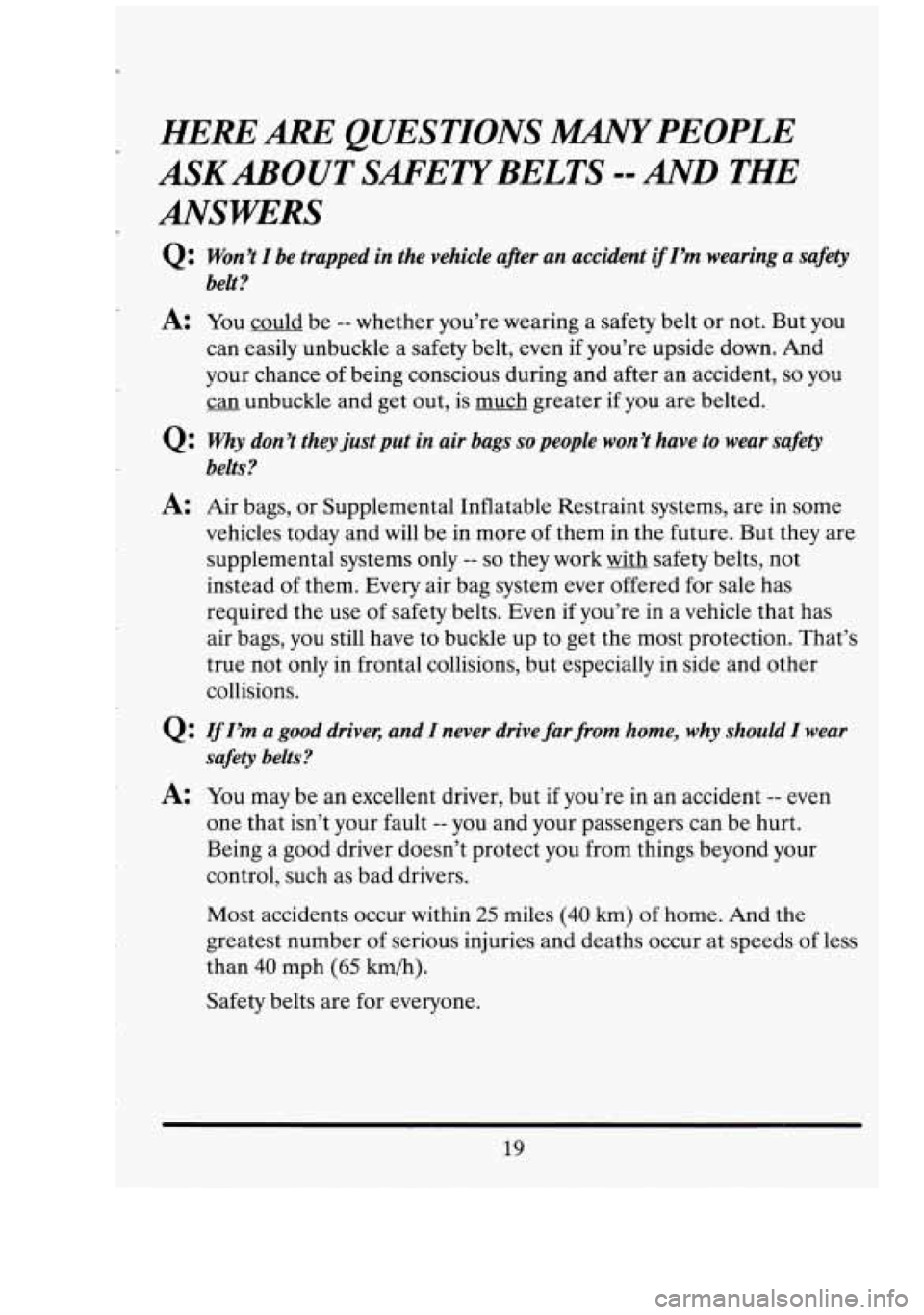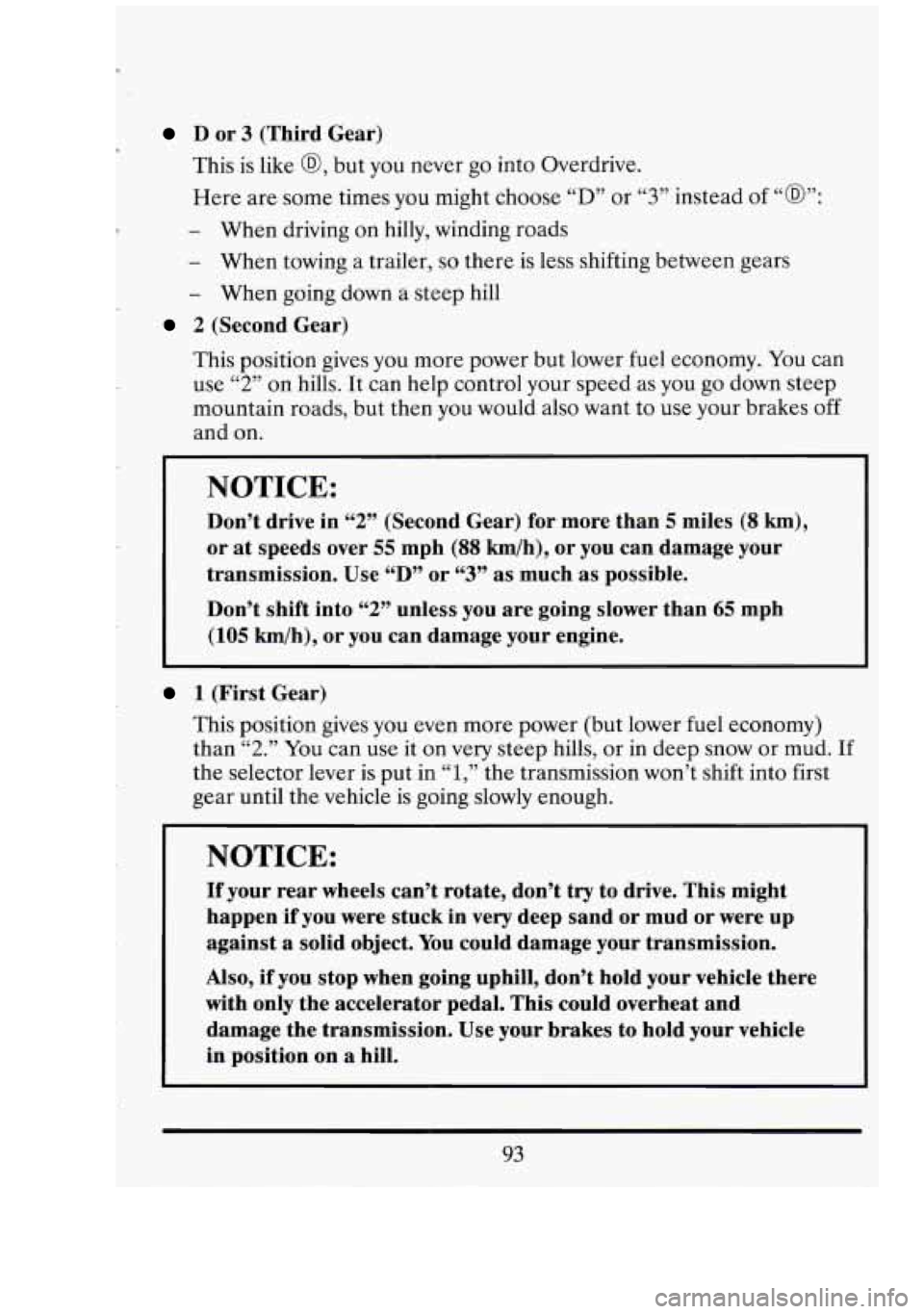Page 32 of 398

HERE ARE QUESTIONS “Y PEOPLE
ANSWERS ASKABOUT SAFETYBELTS
-AND THE
Q: Won’t I be trapped in the vehicle after an accident ifI’m wearing a safety
belt?
A: You could be -- whether you’re wearing a safety belt or not. But you
can easily unbuckle a safety belt, even if you’re upside down. And
your chance
of being conscious during and after an accident, so you
can unbuckle and get out, is much greater if you are belted.
Q: Why don’t they just put in air bags so people won’t have to wear safety
belts?
A: Air bags, or Supplemental Inflatable Restraint systems, are in some
vehicles today and will be in more
of them in the future. But they are
supplemental systems only
-- so they work with safety belts, not
instead
of them. Every air bag system ever offered for sale has
required the use
of safety belts. Even if you’re in a vehicle that has
air bags, you still have to buckle up to get the most protection. That’s
true not only in frontal collisions, but especially in side and other
collisions.
Q : rf I’m a good driver, and I never drive far from home, why should I wear
safety belts?
A: You may be an excellent driver, but if you’re in an accident -- even
one that isn’t your fault
-- you and your passengers can be hurt.
Being a good driver doesn’t protect you from things beyond your
control, such as bad drivers.
Most accidents occur within 25 miles (40 km) of home. And the
greatest number
of serious injuries and deaths occur at speeds of less
than
40 mph (65 kmk).
Safety belts are for everyone.
19
Page 80 of 398
I SECTTON 2 I
FEATURES AND CONTROLS
Here you can learn about the many standard and optional features on
your Cadillac, and information on starting, shifting and braking. Also
explained are the instrument panel and the warning systems that tell you
if everything is working properly
-- and what to do if you have a problem.
KEYS
8
I
I
67
Page 106 of 398

D or 3 (Third Gear)
This is like
@, but you never go into Overdrive.
Here are some times you might choose
“D” or “3” instead of “@”:
- When driving on hilly, winding roads
- When towing a trailer, so there is less shifting between gears
- When going down a steep hill
2 (Second Gear)
This position gives you more power but lower fuel economy.
You can
use
2 on hills. It can help control your speed as you go down steep
mountain roads, but then you would also want to use your brakes off
and on. (6 77
NOTICE:
Don’t drive in “2” (Second Gear) for more than 5 miles (8 km),
or at speeds over 55 mph (88 km/h), or you can damage your
transmission. Use
“D” or “3” as much as possible.
Don’t shift into
“2” unless you are going slower than 65 mph
(105 km/h), or you can damage your engine.
1 (First Gear)
This position gives you even more power (but lower fuel economy)
than
“2.” You can use it on very steep hills, or in deep snow or mud. If
the selector lever is put in “1,” the transmission won’t shift into first
gear until the vehicle is going slowly enough.
NOTICE:
If your rear wheels can’t rotate, don’t try to drive. This might
happen
if you were stuck in very deep sand or mud or were up
against
a solid object. You could damage your transmission.
Also, if you stop when going uphill, don’t hold your vehicle there
with only the accelerator pedal. This could overheat and
damage the transmission. Use your brakes to hold your vehicle
in position on
a hill.
93
Page 116 of 398
r
r_
c-
POWER WTNDOWS
The controls are near each window. Here’s how the master control works.
0 Push the switch
0 Push the switch
forward to
close.
rearward to open.
Express Down Window (Driver’s Side)
Just press the switch once -- for half a second or more -- and then let go.
The window will go all the way down.
If you want to stop the window as it
is going down, press the switch again.
Your vehicle has Retained Accessory Power
(RAP). When you stop your
vehicle and turn the ignition key to
“OFF”, you can still use your power
windows.
The electrical power to the power windows will not shut off
until you open a door or
10 minutes has passed. If you want this power
for another
10 minutes, just turn the,key to “RUN” and then back.to
‘60~~73.
103
Page 118 of 398
The lever on the left side of the steering column includes your:
0 Turn Signal and Lane Change Indicator
0 Headlight High-Low Beam & Passing Signal
Windshield Wipers
0 Windshield Washer
Cruise Control
Turn Signal and Lane Change Indicator
To signal a turn, move
the lever all the way up
or down. When the
turn is finished, the
lever
will return
automatically.
To signal a lane change. slightly move the lever up or down. When the
lane change is finished release the lever.
105
Page 121 of 398
Windshield Wipers
g:
WIPER To control the wipers, turn the band on the multifunction lever.
MIST: Turn the band to “MIST” and then release it for a single wipe
cycle. For more cycles, hold the band on MIST longer.
LO or HI: Turn the band toward you to either LO (low speed) or to HI
(high speed), depending on the wiper speed you want.
DELAY: With this you can set the wiper speed for a long or short delay
between wipes. Move the band to
ON for long delays and the closer you
get to
LO the shorter the delay.
OFF: To turn the wipers off, turn the band to OFF.
Heavy snow
or ice can overload your wiper motor. A circuit breaker will stop
the motor until it cools. Clear away snow or ice to prevent an overload.
108
LJ
n,
i
Page 123 of 398
I
II
3
NOTICE:
When using concentrated washer fluid, follow the
manufacturer’s instructions for adding water.
Don’t mix water with ready-to-use washer fluid. Water can
cause the solution to freeze and damage your washer fluid
tank and other parts
of the washer system. Also, water
doesn’t clean as well as washer fluid.
Fill your washer fluid tank only 3/4 full when it’s very cold.
This allows for expansion, which could damage the tank if it
is completely full.
Don’t use radiator antifreeze in your windshield washer. It
can damage your washer system and paint.
CRUISE CONTROL
With Cruise Control, you can maintain a speed of about 25 mph
(40 km/h) or more without keeping your foot on the accelerator. This
can really help on long trips. Cruise Control does not work at speeds
below about
25 mph (40 kmh).
110
ill
C I
E
I
I
-
J
Page 124 of 398
When you apply your brakes, the Cruise Control shuts off.
To Set Cruise Control
Move the Cruise
Control switch to
“ON.”
0 Get up to the speed you want.
111